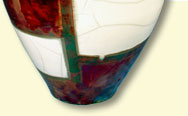



These high temperature pieces begin their life as specially formulated clay which is wheel thrown or hand built. The raw clay piece is fired in an electric kiln to about 1,850 degrees Fahrenheit. Glazes made of finely ground minerals are applied and the ware is then fired in a gas kiln to about 2,400 degrees Fahrenheit. The applied glazes melt and form a glass-like product. Even the clay itself begins to take on glass-like characteristics. Ideally the two materials marry to form surfaces that are impervious to food or drink and can safely be labeled "food and dishwasher safe".

This process has its roots in Japan, several centuries ago. The American version began its evolution on the West Coast about 50 years ago. Ware is taken from the yellow-orange hot kiln with tongs and allowed to cool in an airtight chamber charged with some form of combustible material. This oxygen depleted atmosphere is essential for the development of rich metallic copper colors which emerge after a few minutes. Black surfaces and crackled glazes imbedded with carbon deposits are also prized results of the process.